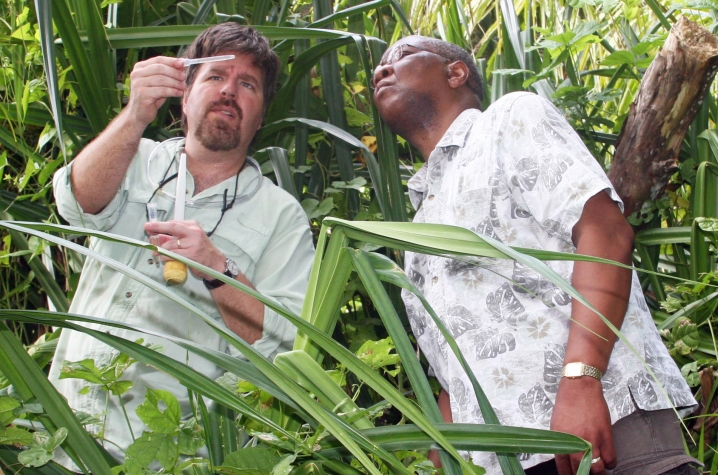Targeting Mosquito-borne Illness in American Samoa

LEXINGTON, Ky. (Feb. 2, 2012) — Debilitating illness, social stigma and disfigurement are only a mosquito bite away in the American Samoa islands, where mosquito-borne diseases such as dengue fever and elephantiasis are a daily reality. But researchers at the University of Kentucky are seeking to change that.
“Elephantiasis is still a real health concern in American Samoa, even though mass drug administration (MDA) has been going on for decades,” said Chike Anyaegbunam, associate professor in the School of Journalism and Telecommunications, part of the UK College of Communications and Information Studies.
Anyaegbunam is a community engagement specialist and a member of a research project aimed at reducing the incidence of lymphatic filariasis in American Samoa. Lymphatic filariasis, a mosquito-borne infection that often leads to elephantiasis, plagues the South Pacific region.
Though elephantiasis is not fatal, it leads to severe physical disability and social stigma. Victims suffer from massive swelling and eventually scarring of the extremities, particularly the legs. Lymphatic filariasis can also lead to kidney damage and swelling of the scrotum in men.
There is no vaccination, and limitations of MDA programs call for supplementary solutions in some environments.
MDA using the drugs diethylcarbamazine (DEC) and albendazole can prevent the disease, but require repeated implementation for at least five years and population-wide adherence to be effective – a tall order in rural communities.
“Unfortunately, the majority of the population has to take that drug year after year until the disease is eradicated, because mosquitoes are the vectors but humans are the carriers,” Anyaegbunam said.
Lymphatic filariasis is caused by the parasitic infection of nematode worms that “nest” in the lymphatic system and reproduce, leading to damage and fluid obstruction. The female Aedes polynesiensis, the Polynesian mosquito, carries the worms’ larvae from human to human.
Reducing mosquito populations appears to be the best apparent solution to the problem, which affects more than 120 million people and is one of the leading causes of disability worldwide.
Enter Stephen Dobson, professor of entomology in the UK College of Agriculture. His pioneering work on “mosquito conditional sterility” renders mosquitoes incapable of reproducing. His team created a procedure to infect mosquitoes with Wolbachia bacteria, which hinders their reproductive capabilities.
“By reducing the mosquito population, we can slow down the transmission of the disease from mosquito to human,” Dobson said. “By infecting male mosquitoes with Wolbachia we can sterilize the population and significantly impact the number of mosquitoes that serve as vectors for mosquito-borne diseases.”
The procedure has worked in the laboratory and an initial field test in French Polynesia demonstrated the effectiveness of the method to control mosquito populations in the wild. But as with most first attempts, the project ran into several hurdles, the tallest of which was rearing enough male mosquitoes to have a significant impact on overall mosquito population sterility.
“We were forced to do much of the rearing by hand. Similar work with agriculturally important insect pests has the benefit of automation and factories, which can literally produce tons of insects a day.
“It was tough work to generate the number of mosquitoes that we had hoped to rear, so that’s a very tangible logistic problem that we need to overcome,” Dobson said.
He is currently partnering with engineers at the University of Kentucky and developing tools to “manufacture mosquitoes.” He hopes that some of these can be used for the next trial that will take place in the American Samoa islands.
Anyaegbunam, who specializes in participatory communication, will accompany Dobson to the American Samoa islands. His role will be to communicate with the community stakeholders to both obtain consent for the project and clarify the project’s methods and goals.
“This is a scientific project and the nuances are difficult to explain to people who are not well versed in scientific language and processes,” Anyaegbunam said.
He will convey that the project is not a genetic modification of the mosquito species. “There’s a lot of activist opposition to GMOs, so we’re trying to avoid that by communicating up front.”
The team’s first trip to American Samoa was in June 2011. Anyaegbunam spoke with government officials, media representatives and community leaders. Dobson and other researchers gathered initial data about the mosquito population.
During the team’s second visit, they will engage community members in conversations to answer questions, address concerns and ensure the community’s support and consent.
“The incidence of mosquito-borne disease like malaria and dengue fever is going up, not down," Dobson said. "There are a lot of diseases becoming worse because people are moving pathogens and mosquitoes all over the world. Tools to control mosquitoes are very much needed. If we’re able to reduce the incidence of this terrible disease, then that supports UK’s commitment to improving public health. Locally, the approach can be applied to other diseases, such as our homegrown Eastern equine encephalitis virus, which is particularly important in Kentucky.”
Relevant also is news of the first dengue transmission on the U.S. mainland in many years, which is ongoing in the Florida Keys.
“Our approach could also be used globally to block dengue transmission and other mosquito-borne diseases,” Dobson said.
The multimillion-dollar project, called “Supplemental Vector Intervention Required to Eliminate Lymphatic Filariasis from the South Pacific,” is supported by funding from a private foundation and governmental sources.
Brianna Bodine received a masters degree in 2011 from the UK Graduate Program in Communication. This article was published previously in the Department of Communication's "Graduate Standard."




